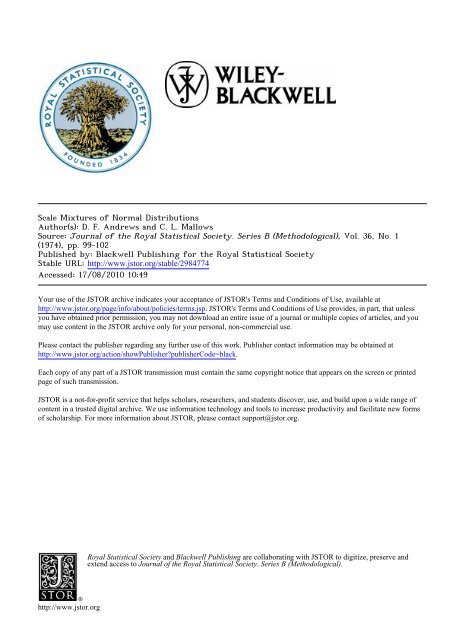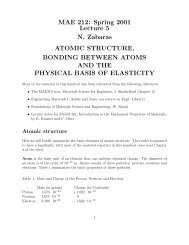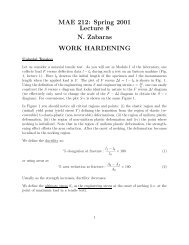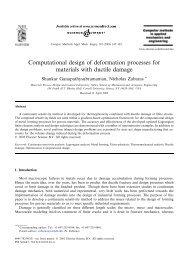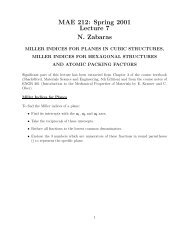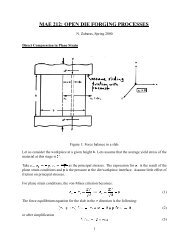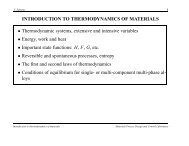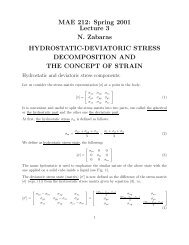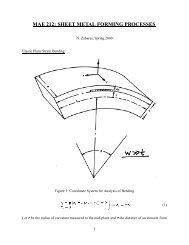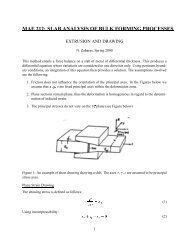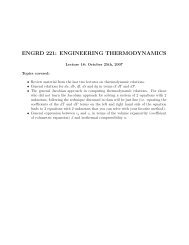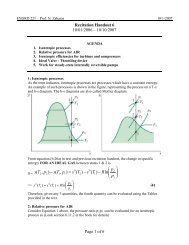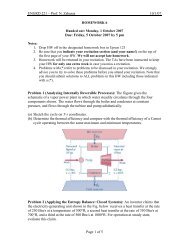Scale Mixtures of Normal Distributions
Scale Mixtures of Normal Distributions
Scale Mixtures of Normal Distributions
Create successful ePaper yourself
Turn your PDF publications into a flip-book with our unique Google optimized e-Paper software.
<strong>Scale</strong> <strong>Mixtures</strong> <strong>of</strong> <strong>Normal</strong> <strong>Distributions</strong><br />
Author(s): D. F. Andrews and C. L. Mallows<br />
Source: Journal <strong>of</strong> the Royal Statistical Society. Series B (Methodological), Vol. 36, No. 1<br />
(1974), pp. 99-102<br />
Published by: Blackwell Publishing for the Royal Statistical Society<br />
Stable URL: http://www.jstor.org/stable/2984774<br />
Accessed: 17/08/2010 10:49<br />
Your use <strong>of</strong> the JSTOR archive indicates your acceptance <strong>of</strong> JSTOR's Terms and Conditions <strong>of</strong> Use, available at<br />
http://www.jstor.org/page/info/about/policies/terms.jsp. JSTOR's Terms and Conditions <strong>of</strong> Use provides, in part, that unless<br />
you have obtained prior permission, you may not download an entire issue <strong>of</strong> a journal or multiple copies <strong>of</strong> articles, and you<br />
may use content in the JSTOR archive only for your personal, non-commercial use.<br />
Please contact the publisher regarding any further use <strong>of</strong> this work. Publisher contact information may be obtained at<br />
http://www.jstor.org/action/showPublisher?publisherCode=black.<br />
Each copy <strong>of</strong> any part <strong>of</strong> a JSTOR transmission must contain the same copyright notice that appears on the screen or printed<br />
page <strong>of</strong> such transmission.<br />
JSTOR is a not-for-pr<strong>of</strong>it service that helps scholars, researchers, and students discover, use, and build upon a wide range <strong>of</strong><br />
content in a trusted digital archive. We use information technology and tools to increase productivity and facilitate new forms<br />
<strong>of</strong> scholarship. For more information about JSTOR, please contact support@jstor.org.<br />
Royal Statistical Society and Blackwell Publishing are collaborating with JSTOR to digitize, preserve and<br />
extend access to Journal <strong>of</strong> the Royal Statistical Society. Series B (Methodological).<br />
http://www.jstor.org
1974] 99<br />
<strong>Scale</strong> <strong>Mixtures</strong> <strong>of</strong> <strong>Normal</strong> <strong>Distributions</strong><br />
By D. F. ANDREWS and C. L. MALLOWS<br />
Bell Laboratories<br />
and University <strong>of</strong> Toronto<br />
[Received April 1973]<br />
Bell Laboratories<br />
SUMMARY<br />
This paper presents necessary and sufficient conditions under which a random<br />
variable X may be generated as the ratio ZI V where Z and V are independent<br />
and Z has a standard normal distribution. This representation is useful in<br />
Monte Carlo calculations. It is established that when 7 V2 is exponential,<br />
X is double exponential; and that when WV has the asymptotic distribution<br />
<strong>of</strong> the Kolmogorov distance statistic, X is logistic.<br />
Keywords: SCALE MIXTURES; MONTE CARLO; LOGISTIC; STABLE<br />
1. INTRODUCTION<br />
RECENTLY Relles (1970) and Andrews et al. (1972) have exploited some properties<br />
<strong>of</strong> the normal distribution in Monte Carlo evaluations. These techniques are useful<br />
when sampling from (symmetric) distributions which can be generated as the ratio<br />
X = Z/ V where Z has a standard normal distribution and V is positive and is independent<br />
<strong>of</strong> Z.<br />
Given X, it is <strong>of</strong> interes to know whether such a representation exists and to<br />
determine ways <strong>of</strong> finding the distribution <strong>of</strong> the denominator V. Beale and Mallows<br />
(1959) studied this problem; the conditions presented here extend their results and<br />
involve the density function and its derivatives. In some cases they may be easier<br />
to check than the characteristic-function results presented by Beale and Mallows.<br />
2. THE FUNDAMENTAL RELATION<br />
Let the distribution function (d.f.) <strong>of</strong> V be Gv. It is easy to see that if X = Z/ V<br />
then for all non-zero x, X necessarily has a density fxy(x) given by<br />
fx(x) = (27)A v exp {- 2V2 X2} dGv(v) (2.1)<br />
and fx(O) exists if and only if E(V) is finite. We now show that the density <strong>of</strong> X is<br />
essentially the Laplace transform <strong>of</strong> a function related to the d.f. Gv.<br />
Lemma. If h(y) = fx(Jy), h is the Laplace transform <strong>of</strong> H where<br />
H(t)=<br />
{(ufT)l dGv{(2u)}.<br />
Pro<strong>of</strong>. Put v = (2u)' in (2.1).<br />
In many cases tables <strong>of</strong> Laplace transforms may be used to find H and hence Gv.<br />
Where Gv is differentiable, we have<br />
H'(t) = (2,7T)- G'{(2t)%}, G'(v) = (27T)- H'(-v2).
100 ANDREWS AND MALLOWS - <strong>Scale</strong> <strong>Mixtures</strong> <strong>of</strong> <strong>Distributions</strong> [No. 1,<br />
Also, wheneverfx(x) has the representation (2.1), the Laplace transform <strong>of</strong> G can<br />
be obtained directly:<br />
by using the relation<br />
2 fx(x) exp {- 2t2 X-2} dx = fexp {- vt} dG(v)<br />
exp { -(a2 u2 + b2 u2)} du = (7T/2a2)' exp {- ab i }. (2.2)<br />
3. NECESSARY AND SUFFICIENT CONDITIONS<br />
The following theorem establishes necessary and sufficient conditions for this<br />
representation to exist.<br />
Theorem. If X has a density function fx symmetric about 0 then there exist<br />
independent random variables V, Z with Z standard normal such that Z/ V = X if<br />
and only if the derivatives <strong>of</strong>fx satisfy<br />
()dy) fx(Y) >O for y> 0. (3.1)<br />
Pro<strong>of</strong>. The necessity follows from differentiating (2.1) (with x = y2) with respect<br />
toy.<br />
The sufficiency follows from Bernstein's theorem (see Feller, 1966, p. 416, or<br />
Widder, 1946, p. 161), according to which under (3.1) fx(y1) is a Laplace transform<br />
h(y) =fx(yl) =<br />
exp { -yt} dox(t),<br />
where oc(t) is non-decreasing and the integral converges for 0< y < oo. Letting<br />
A(w) = f<br />
rw2/2<br />
V1(27JT)<br />
dc(x{v2), w> O<br />
the density may be written<br />
fx(x) =<br />
(27T)-i v exp {- Iv2 x2} dA(v).<br />
Now A is non-decreasing. It remains to show that<br />
lim {A(u)-A(u-1)} = 1<br />
u->00<br />
so that G(v) = A(v) - A(O) is a proper d.f. Let<br />
f(u, x) =<br />
u<br />
(27T)-i v exp {- v2 x2} dA(v)<br />
so that<br />
ff(u, x) dx = A(u) -A(u-1).<br />
Since the integrand <strong>of</strong> f(u, x), is positive for all v >0, we have<br />
0 < tfl, wet<br />
r fx() x>
1974] ANDREWS AND MALLOWS - <strong>Scale</strong> <strong>Mixtures</strong> <strong>of</strong> <strong>Distributions</strong> 101<br />
Furthermore, f(u, x) converges monotonically to f at all x as u -+ co. Hence by the<br />
monotone convergence theorem<br />
and the theorem is proved.<br />
lim ff(u x) dx = f(x) dx = 1<br />
4. EXAMPLES<br />
4.1. The t-distribution density is a special case <strong>of</strong> the Pearson Type VII density<br />
fX(X) = {aB(,M - 12)}-1 (1 + X2/a2)-m.<br />
Clearly h(y) =fx(yl) has derivatives <strong>of</strong> alternating sign. The inverse transform<br />
<strong>of</strong> h(y) is<br />
7T-I{F(m - 2)}-1 a2m-1 tm-i exp {- a2 t}<br />
which when equated to (2r)-1 GV{(2t)I} yields<br />
G'(v)= {M(m- )}-' (2a2 V2)m-1 a2 v exp {--a2 v2}<br />
so that ja2 V2 has a gamma distribution with shape parameter m - 1. Thus aV is X<br />
with 2m -I degrees <strong>of</strong> freedom.<br />
When m = 1 so that X is Cauchy, V is X with one degree <strong>of</strong> freedom, i.e. halfnormal.<br />
4.2. The Laplace or double exponential distribution has density<br />
fx(x) = 1exp{-IxI}.<br />
A simple induction will establish that h(y) =fx(y4) has derivatives <strong>of</strong> alternating<br />
sign. The inverse transform <strong>of</strong> h(y) is<br />
4(-rt3)-exp {- (4t)-1}<br />
which when equated to (2a)-' GV{(2t)I} yields<br />
G'(v) - V-3 exp {-(2v2)-l}.<br />
That is, (2V2)-' has an exponential distribution.<br />
4.3. The logistic distribution has density<br />
so that<br />
fx(x)<br />
h(y)<br />
Now h(y) is the transform <strong>of</strong><br />
whence<br />
00<br />
exp {-x} [1 + exp {-x}]-2<br />
00<br />
E (- l)k-l k exp {-ky}.<br />
k=1<br />
z (- l)k-1 k2(47rt3)-'exp {- k2/4t},<br />
k=1<br />
GV(V) = 2 E (-l)k-l k2 V-3 exp {k2/2v2}.<br />
k=1
102 ANDREWS AND MALLOWS - <strong>Scale</strong> <strong>Mixtures</strong> <strong>of</strong> <strong>Distributions</strong> [No. 1,<br />
Thus here (2 V)-1 has the asymptotic distribution <strong>of</strong> the Kolmogorov distance statistic.<br />
The result, that 2ZK is logistic when Z and K are independent, normal and asymptotic<br />
Kolmogorov respectively, can be established directly using the integral (2.2) but we<br />
know <strong>of</strong> no probabilistic interpretation <strong>of</strong> this relation.<br />
To use this result in Monte Carlo work we have to be able to generate pseudorandom<br />
variables having the asymptotic Kolmogorov distribution. One possibility<br />
is to use the relation found by Watson (1961), namely<br />
2K2- E W/j2,<br />
j=1<br />
where W1, W2,... are independent exponential variables. This and some other ideas<br />
are currently under consideration.<br />
4.4. One case where the present methods are <strong>of</strong> little help is when X is stable (and<br />
symmetric) with exponent a < 2. It is known (Feller, 1966, p. 172) that such a variable<br />
can be represented as X = Z/ V where 1/V2 is (positive) stable with exponent -x.<br />
However, if aO 1 it is not clear how to prove this by the present method. (Also we<br />
do not know how to generate pseudo-random positive stable variables.)<br />
REFERENCES<br />
ANDREWS, D. F., BICKEL, P. J., HAMPEL, F. R., HUBER, P. J., ROGERS, W. H. and TUKEY, J. W.<br />
(1972). Robust Estimates <strong>of</strong> Location: Survey and Advances. Princeton: Princeton University<br />
Press.<br />
BEALE, E. M. L. and MALLOWS, C. L. (1959). <strong>Scale</strong> mixing <strong>of</strong> symmetric distributions with zero<br />
means. Ann. Math. Statist., 40, 1145-1151.<br />
FELLER, W. (1966). An Introduction to Probability Theory and Its Applications, Vol. II. New York:<br />
Wiley.<br />
RELLES, D. A. (1970). Variance reduction techniques for Monte Carlo sampling from Student<br />
distributions. Technometrics, 12, 499-515.<br />
WATSON, G. S. (1961). Goodness-<strong>of</strong>-fit tests on a circle. Biometrika, 48, 109-114.<br />
WIDDER, D. V. (1946). The Laplace Transform. Princeton: Princeton University Press.


